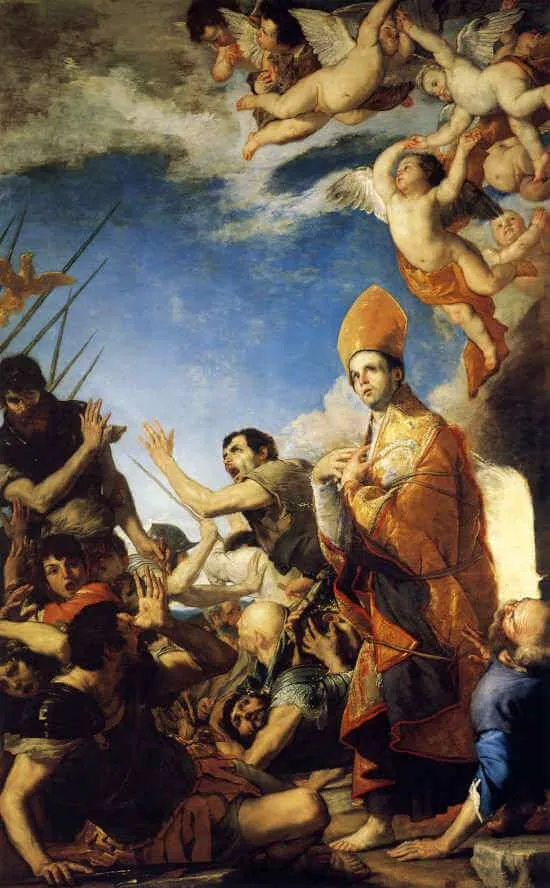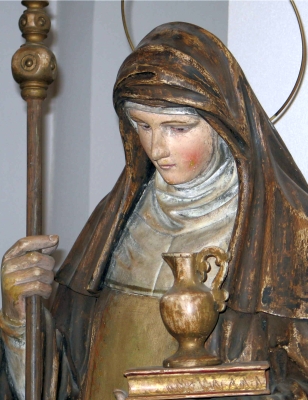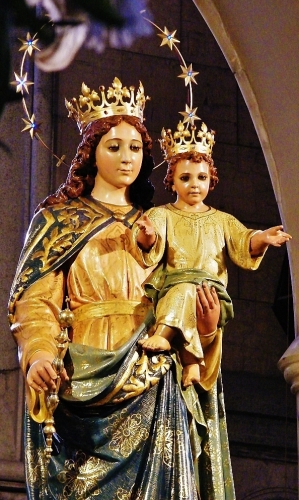Died c. 304; Patron Saint of Naples, Italy and blood banks; Invoked against volcanic eruptions; Pre-Congregation canonization
The third-century theologian Tertullian famously wrote, “The more we are mown down by you, the more in number we grow; the blood of Christians is seed.” Sometimes, his phrase is translated as, “The blood of the martyrs is the seed of the Church” (Apologeticus, L.13). There has been no time when this phrase rang truer than in the Roman Empire between the years 303 and 313. In 303 and 304, the Roman Emperor Diocletian issued a series of edicts initiating what has come to be known as the “Great Persecution.” Though the exact reason for this persecution remains unclear, many Christians were imprisoned, tortured, and killed. Others had their properties confiscated or were sent to work in mines under harsh conditions. Among the most famous martyrs of this persecution are Saints George, Catherine of Alexandria, Agnes, Sebastian, Vincent, Pancras, Cosmas, Damian, Anastasia, Lucy, and today’s saint, Saint Januarius.
Januarius is believed to have been born into a wealthy aristocratic family in the city of Benevento, located about 150 miles southeast of Rome, via the Appian Way. Little is known for certain about Januarius’ childhood and life, aside from what was recorded centuries later in various legends. One legend states that he became a priest at the age of fifteen in Benevento and the bishop of either Benevento or Naples at twenty.
When persecutions under Emperor Diocletian began in 303 and 304, chaos ensued across the empire, including Naples. According to legend, four of Bishop Januarius’ friends were arrested: two deacons named Sosius and Proculus, and two laymen named Eutyches and Acutius. To encourage them, Bishop Januarius went to visit them in prison. However, during his visit, he too was arrested and imprisoned by Timothy, the Governor of Campania. Shortly afterward, the bishop’s deacon, Festus, and a lay lector named Desiderius were also arrested when they came to visit Bishop Januarius.
During their interrogations, each Christian boldly professed his faith. They were threatened with death if they refused to offer sacrifices to the Roman gods, but they refused. Consequently, an order was issued for them to be burned. However, when Bishop Januarius was thrown into the flames, he remained unharmed. Next, it was decreed that they be fed to wild beasts in the arena. According to one legend, the beasts became docile and refused to devour them. Ultimately, they were ordered to be beheaded. When the executioner approached, he was struck blind, but Bishop Januarius cured him in front of everyone, leading to many conversions.
After consenting to their martyrdom, all seven men were beheaded. Saint Januarius’ body was taken to Naples and buried in the principal church. Since then, many miracles have been reported by those who prayed at his tomb. It is believed that Naples was saved from volcanic eruptions from nearby Mount Vesuvius due to these miracles.
Though his heroic martyrdom is the greatest witness he could offer, God has continued to use Saint Januarius in a mysterious and ongoing way. Legend holds that, after his death, a holy woman named Eusebia collected some of his blood and stored it in two glass vials. That blood, the blood of a martyr, was later enshrined in the church next to his body. Veneration of Saint Januarius began soon after his death. At some point, an ongoing miraculous phenomenon began to occur. Every year, three times each year, his dried blood liquefies in the presence of the faithful. On some occasions, the blood fails to liquefy, which some interpret as a sign that the faithful should pray for an impending threat to the city. The first written record of the liquefaction of Saint Januarius’ blood is believed to be from 1389, as noted in the chronicle of the cleric Giovanni Diacono of Naples. Records of this annual miracle have continued ever since.
Today, the blood is enclosed in a silver reliquary containing two hermetically sealed vials. The larger one is about four inches high and two and a quarter inches in diameter. Throughout the year, the blood appears as an opaque, dark, and solid mass when viewed in the light. When turned to the side, it does not move. The first instance of liquefaction is on the Saturday before the first Sunday of May, commemorating the translation of the saint’s relics to Naples. The second time is on September 19, the feast of Saint Januarius. The third event takes place on the anniversary of the 1631 eruption of Mount Vesuvius, December 16, when a silver bust believed to house the skull of Saint Januarius is placed on the altar, and the blood is brought out for veneration. The liquefaction usually occurs during the first two times but often fails on December 16.
Although scientists have attempted to explain this phenomenon, no one has successfully cast sufficient doubt on its miraculous nature. It remains a source of deep devotion for Catholics in Naples and continues to inspire many worldwide.
As we honor this ancient saint who continues to inspire us today, ponder the simple truth that miracles do happen. For God, miracles are easy. However, miracles should never be the foundation of our faith in God. True faith comes only from a personal encounter with the Living Lord. Ponder the depth of your own faith. Though this miracle should inspire you, look more deeply and ponder the true source of faith in your life. Seek out the voice of God as that source, spoken gently to you in your conscience. Listen to Him and allow Him to reveal Himself to you, so that God and God alone is the true source of all that you believe and all that you do.
Source: https://mycatholic.life/saints/saints-of-the-liturgical-year/september-19–st-januarius-martyr/








